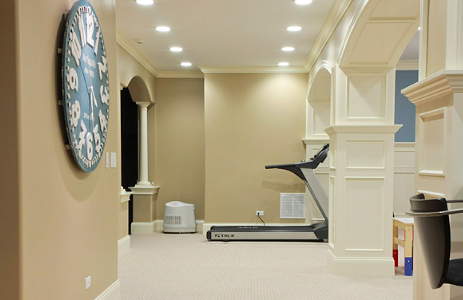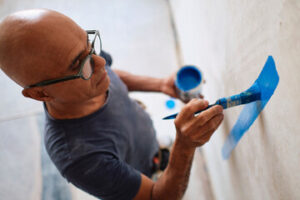A professional painter can breathe new life into your home and create the look and ambiance you’ve always wanted. However, figuring out which contractor best suits your needs can be confusing. Residential painting contractors usually work within regular, scheduled daytime hours. They are prepared with basic equipment similar to what you might find in a local hardware store: step ladders, brushes, rollers, trays, and cleaning materials. Visit Website to learn more.
Solid Color Stain
 Stains offer two advantages over paint: They protect the exposed surface and they also create a visual appeal. Stains are available in a variety of colors and they can be used on a range of different surfaces. Depending on the type of stain you choose, the color will last up to 7 years and it can be easily sanded down and reapplied.
Stains offer two advantages over paint: They protect the exposed surface and they also create a visual appeal. Stains are available in a variety of colors and they can be used on a range of different surfaces. Depending on the type of stain you choose, the color will last up to 7 years and it can be easily sanded down and reapplied.
A solid color stain is a rich opaque finish that allows the natural texture of a material to show through. This is a great option for wood decks and other exterior projects where you want the look of wood but need to hide imperfections or damage. This type of stain is also available in many sheens so you can choose the look that best suits your home’s aesthetic.
Solid stains absorb into the material they are covering, which is why they tend to hold up better over time than paint does. Stains also deteriorate more slowly and they don’t peel the way that paint can. A residential painting contractor can help you decide if a solid stain is the right option for your project.
When you think of a stain, you may automatically think of a clear varnish-like substance reserved for wooden porches and deck chairs. But stains are actually used for much more than that. Stains are a very versatile product that can be applied to any type of surface, from hardwood floors to brick walls. They come in a wide variety of colors and can be applied in many different sheens, from matte to glossy.
Another great thing about stains is that they are easy to apply, which makes them a cost-effective option for most homeowners. Stains are also water-resistant and durable, which means they can withstand most weather conditions. However, if you are going to use a stain on your exterior wood surfaces, it is important to keep in mind that these types of stains need to be reapplied every year or so.
When you choose a stain, it is best to test the color on a small area before committing to it. This is especially important if you have previously stained the surface or painted it in the past. Stains and paint are influenced by temperature, texture, grain porosity, and species of the wood or surface you are applying it to.
Checkerboard Pattern
Checkerboards have long been a popular motif in design, both as flooring and on other surfaces. Although stripes and plaids are also timeless classics, a checkerboard pattern feels more whimsical than those styles and can introduce visual interest into a space without feeling busy or overdone. This pattern is also easy to execute, making it a great choice for novice DIYers.
A traditional checkerboard is made of two colors, typically one light and a dark shade, but it can be as simple or as complicated as you like. Black and white is a common option, but you can choose any two colors that work well together. The key is to select complementary shades that are close in hue so that they look balanced and well-matched when painted side-by-side.
While checkerboard floors are the most obvious choice, the pattern is also making a comeback in soft furnishings, such as curtains and upholstered furniture. Choosing a neutral, deconstructed check in your favorite color can make for a sophisticated choice that fits with any aesthetic, or you can go with a bolder collage pattern to suit a more eclectic style.
If you want to try a checkerboard pattern on your walls, start by painting a base coat using the lighter of the two colors you’ll be using for the checkerboard. Allow this coat to dry completely before starting the painting process.
Next, use a carpenter’s level and pencil to mark out the squares you’ll be painting on your wall. Be sure to account for the width of your painter’s tape when measuring out your squares so that they are all the same size. Make sure that your tape goes over the squares you’ll be painting and not into them to avoid leakage and confusion.
Once your squares are all marked out, begin painting the second color on every other row. After completing these rows, remove the tape and let them dry completely. You can then apply a clear sealant to your checkerboard to protect it from wear and tear.
Adding a checkerboard floor to your home is a beautiful way to make it stand out from the rest of the house. It’s an especially great idea for high-traffic areas, as it can withstand more foot traffic than a solid color floor would.
Paint the Ceilings
A painted ceiling is an easy way to make any room feel more spacious and stately. However, painting high ceilings can be a daunting task, especially for those not used to it. The trick is to paint the ceiling in small sections and to keep the paint saturating and wet as you go along. This makes it much easier to blend the sections once they are dry. Two coats are recommended to ensure even coverage.
The first step to take when painting the ceiling is to mask the tops of the walls and crown molding with tape. This will help prevent the ceiling paint bleeding into the wall and also make it easier to clean up any mistakes as you work.
Before you start painting, you should also remove as much furniture as possible from the room to make it easier to move and maneuver around. You should also hang plastic sheeting over windows and doors to protect them from the spray of the ceiling paint.
Once you are ready to begin, start by saturating the roller with paint and then rolling on the ceiling in 3-foot by 3-foot sections. It is helpful to overlap each section by a few inches with the previous one to ensure that there are no paint spots. This will help prevent permanent roller marks and will also ensure that you have an even coverage. When you are finished, apply a second coat of ceiling paint if necessary.
Residential painters use similar tools as any other home improvement contractor would, but they typically have more in stock because they are working on smaller projects. These contractors usually have a number of different ladders, all-in-one roller and paint container systems like the Wagner PaintStick EZ-Twist, and handheld brushes for getting in tight corners where rollers cannot reach.
Regardless of whether the paint is oil-based or latex, it should always be mixed before applying it to your walls or ceilings. This will allow all the components to mix well together and will help the paint adhere better to your surfaces. It is also important to stir the paint often to ensure that it is consistent.
Adding Trim
Residential painters have the experience and skills to work with homeowners to create a vision for their home’s interior. The vision may include specific color choices or decorative features such as running trim or dentils. It may also encompass a variety of textures or materials that require special treatment.
Adding decorative trim to a room’s wall can help define the space, hide unsightly cracks and scuff marks, and create a focal point around a fireplace or window. It can also add a level of elegance and beauty that will make the room stand out from other homes. The trim color can be a solid or textured shade to match the walls and other decorations.
The best time to paint trim is after the walls have been painted and dry. Before you begin painting, it is a good idea to clean the trim with a household cleaner and a rag. This will remove any dust or dirt that could cause the paint to clump when it dries. You should also wipe down all surfaces that will be painted.
If you are painting wood trim, it is a good idea to use a primer before you apply the finish coat. This will ensure that the trim will not absorb too much of the paint and will hold up well to everyday wear and tear. After the primer is dry, it is a good idea to sand the surface to smooth any rough areas.
When you are ready to paint, you should first move any furniture that is in the way and cover it with plastic or fabric drop cloths. Then, tape off any areas that you do not want to paint and use a detail squeegee to press the tape firmly into place. If you do not have a detail squeegee, you can use a household putty knife or scraper to get the same results.
When you are finished, you can enjoy your newly-painted rooms and a beautiful home. Residential painters have the skills and tools to help you create the look you have always wanted for your home’s interior. They can also offer suggestions on the best colors to choose and the most effective ways to prepare a room for painting.


